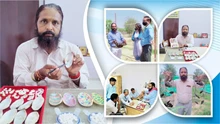
Crop spoilage, particularly of sugarcane and rice, increased in the areas surrounding Maharashtra between 2017 and 21. Considering the plight of farmers as a result of rainwater overflow caused by deforestation, the government decided to compensate the farmers most affected by the floods.
About Jaltara Project:
JalTara is Sri Sri Ravishankar's idea to revitalize India's current water problems. Ravisankar is the founder of Art of Living. The project aims to make a positive difference in the lives of farmers and villagers by putting an end to the problems of flooding and drought in rural areas. The audacious plan aims to recharge over 30 trillion litres of groundwater in India each year.
The JalTara Project is a thoughtful initiative to address India's water scarcity. The primary goal is to train farmers and villagers, who are the most important stakeholders in this project, to conserve monsoon water every year and store it in underground aquifers- an integrated team of experienced geologists, watershed experts, and project management experts has been assembled for this purpose.
The JalTara methodology is quite effective, and the problem lies in proper rainwater disposal and efficient groundwater management. Groundwater is the lifeblood of Indian agriculture. It supplies more than 80% of India's water and agricultural needs, but the groundwater level has been rapidly declining in recent years. The availability has been hampered in recent years due to deforestation and a disrupted hydrological cycle. It has resulted in multi-dimensional water stress situations in the majority of India's villages and farms.
JalTara's approach effectively targets this problem statement. People must rely on sources other than groundwater to meet their hydrological needs, and rainwater must be managed effectively. The concept of recharge pits was developed in order to increase India's groundwater storage by trillions of dollars per year and alleviate the water crisis. The exemplary and unwavering efforts of the sevaks at Art of Living have contributed to a few litres, with more on the way.
Importance of JalTara Project:
JalTara planned to expand its base to districts in Maharashtra by 2022. So far, it has met its objectives under the direction of the Art of Living foundation. The water table has risen by 12-14 feet, resulting in an increase of 6.06 lakh litres per pit and 30.3 crore litres of water per village. This enabled farmers to water more frequently and reduce the impact of waterlogged fields, resulting in a 42% increase in crop yield and a 120% increase in farmer income, despite the fact that there was not a single reported case of spoiled crops due to waterlogging.
The primary goal has been to educate the villagers about the long-term value of water rejuvenation through tree planting, as well as to validate the 'recharge pit in every arable plot' methodology and demonstrate the projected benefits. Simple, standard pits are massively scalable, with the ability to dig 4.5 pits per hour.











